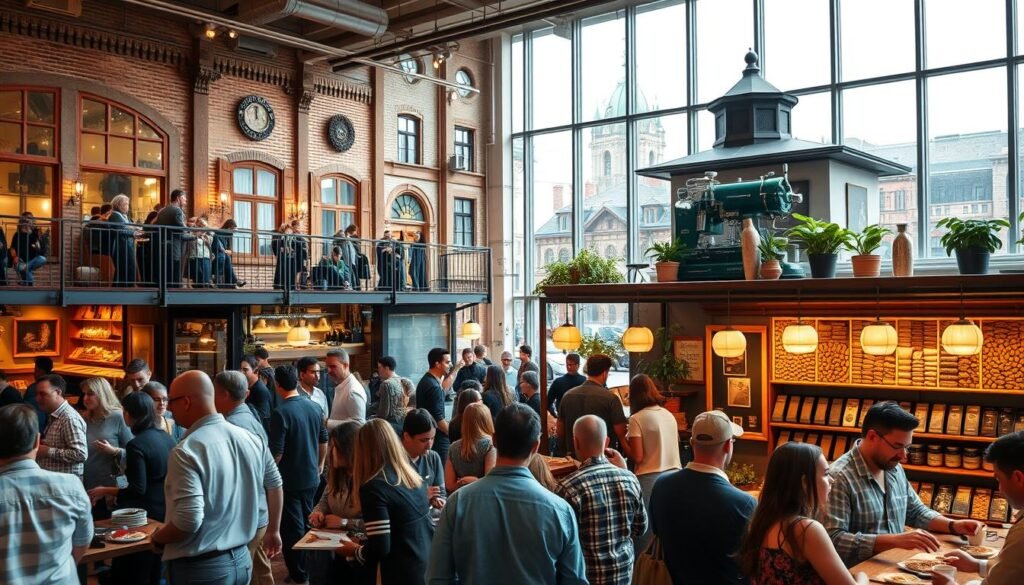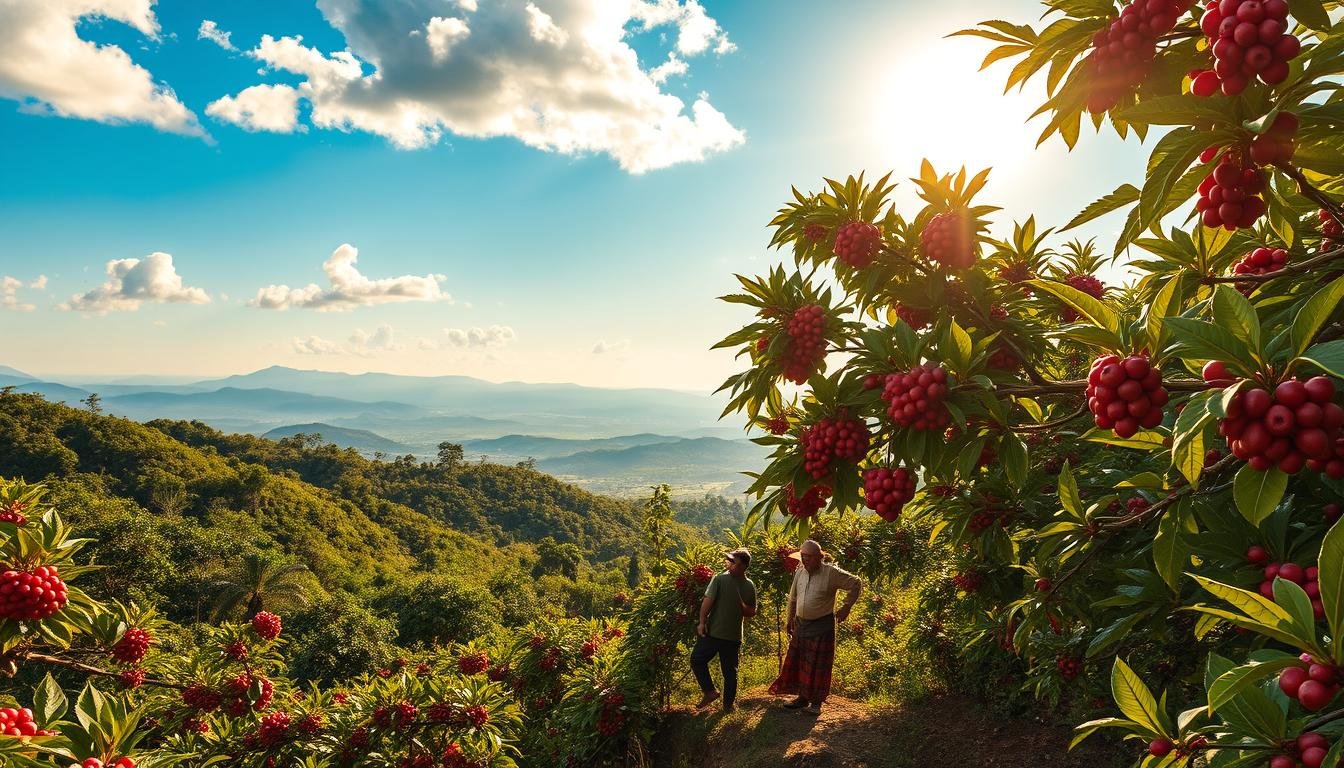Coffee is more than just a beverage; it is a global phenomenon that intertwines with culture, economics, and society in multifaceted ways. This section delves into the origins of coffee, its spread across the world, and its profound influence on societies worldwide. The story of coffee begins in Ethiopia, where a goat herder named Kaldi is credited with its discovery. Coffee then spread to the Arabian Peninsula, flourishing in Yemen, before making its way to Europe, the Americas, and beyond, transforming into a global commodity.
Key Takeaways
- Coffee has a rich history that dates back to its discovery in Ethiopia and subsequent spread to the Arabian Peninsula and the rest of the world.
- The global diffusion of coffee has profoundly impacted the economies, ecologies, and cultural traditions of many regions.
- Coffee has evolved from being an elixir embraced by Ethiopian monks to becoming a social and intellectual hub in European coffeehouses.
- Coffee’s versatility extends beyond a beverage, as it is utilized in culinary creations and beauty products.
- The history and cultural significance of coffee are intricately woven into the fabric of societies around the globe.
Origins and Spread of Coffee Cultivation
The captivating story of coffee’s origins can be traced back to the highlands of Ethiopia, where a goat herder named Kaldi is said to have discovered the energizing properties of coffee beans. Kaldi noticed his goats becoming lively after consuming the red berries from a particular bush, leading him to share his discovery with the monks at a local monastery. These monks then devised a way to prepare a drink from the beans, finding it kept them alert during their devotions. This marked the beginning of coffee’s remarkable journey across the globe.
Spread to the Arabian Peninsula and Beyond
Coffee’s popularity quickly spread to the Arabian Peninsula, where it flourished in Yemen. Sufi monks in the region used coffee to sustain their spiritual devotions, and the port city of Mocha became a pivotal coffee trading center. By the 15th and 16th centuries, coffee had reached the rest of the Middle East, Persia, Turkey, and North Africa, becoming a staple of public life through the establishment of coffeehouses.
The journey of coffee continued, with European traders introducing it to new regions. In the late 17th century, coffee made its way to Europe, with the first coffee house opening in Venice, Italy, in 1645. From there, the popularity of coffee spread rapidly, with the first coffee house in England opening in Oxford in 1651, and the trend soon catching on in London and across the continent.
As the demand for coffee grew, so did its cultivation. European traders began to grow coffee in other regions, such as the Dutch introducing it to Indonesia, which became one of the world’s top coffee producers. By the 18th century, coffee cultivation had also reached Latin America, with Captain John Smith introducing it to settlers in Jamestown in 1607. Today, Brazil is the largest coffee producer in the world, responsible for around one-third of the global supply.
“Coffee made its way north from Ethiopia to Yemen in the 15th century and was known in Persia, Egypt, Syria, and Turkey by the 16th century.”
The global coffee trade has played a significant role in shaping the coffee history and coffee cultivation across the world. From its humble beginnings in the Ethiopian highlands to its global dominance, coffee has become one of the most valuable traded natural commodities, second only to oil.
Diverse Preparation Methods and Cultural Rituals
Coffee’s preparation varies significantly around the world, reflecting the diverse cultural traditions that have embraced this beloved beverage. From the birthplace of coffee in Ethiopia to the iconic Turkish coffee, the ways in which coffee is prepared and consumed offer a glimpse into the deep-rooted significance of this drink in different societies.
Ethiopian Coffee Ceremony
In Ethiopia, the coffee ceremony is a fundamental social event. The beans are meticulously roasted, ground, and brewed in a pot called a ‘jebena,’ often with the addition of spices. This elaborate ritual, known as Buna, is considered a sacred tradition that promotes community bonding and cultural unity.
Turkish Coffee and Fortune-Telling Traditions
Turkish coffee is renowned for its strong preparation, involving finely ground coffee beans brewed with sugar in a special pot called a ‘cezve.’ Beyond its distinctive taste, Turkish coffee has also been historically associated with the practice of tasseography, or fortune-telling using the settled coffee grounds in the cup. This centuries-old tradition has been integral to Middle Eastern and Balkan cultures.
These diverse coffee preparation methods and cultural rituals surrounding coffee consumption highlight the deep-rooted significance of this beverage in different societies. From the meditative pause of the Italian espresso to the communal gatherings in Central America, coffee has become a unifying force that transcends borders and cultures.
Coffee as a Social and Intellectual Catalyst

Coffee houses have long been at the heart of social and intellectual exchange, serving as vibrant hubs for diverse communities to gather, converse, and explore new ideas. Tracing their origins to the Ottoman Empire, where Muslims abstained from alcohol, coffee houses became vital gathering spaces, planting the seeds for what philosophers call the “public sphere” – a realm once dominated by elites that expanded to include a broader mix of people.
In Europe, coffee house patrons were instrumental in shaping new ways to handle economies and politics. Iconic institutions like the London Stock Exchange, Lloyd’s of London, and the East India Company all had their beginnings in these lively coffee houses, which in London became known as “penny universities” – places where the price of a cup of coffee gave patrons access to ongoing intellectual discourse.
Coffeehouses and the Birth of the Public Sphere
The impact of coffee houses extended across the Atlantic, with colonial America’s Green Dragon Tavern and coffeehouse in Boston gaining fame as a meeting place for leaders of the Sons of Liberty to hatch revolutionary ideas. As hubs of social and political activity, coffee houses played a pivotal role in shaping the public discourse and fostering a sense of community and shared purpose.
| Coffee and Social Impact | Key Highlights |
|---|---|
| Coffee Houses as Intellectual Hubs |
|
| Coffee Houses and the American Revolution |
|
| Coffee and Social Change |
|
Today, the legacy of coffee houses as hubs of social and intellectual exchange continues to evolve, as the coffee industry increasingly aligns with social change movements and fosters ethical, sustainable practices that empower communities. From supporting marginalized groups to driving collective action through conscious consumption, coffee remains a catalyst for shaping the public sphere and inspiring transformative social and cultural impact.
the history and cultural significance of coffee around the globe

Coffee’s journey from a humble berry to a global phenomenon encapsulates its profound influence on society, economy, and culture. It bridges continents and cultures, fostering connections and conversations. Coffee’s cultural impact is profound, playing a crucial role in social interactions and hospitality in many societies.
From the communal atmosphere of Italian espresso bars to the vibrant coffee shop culture in the United States, coffee has become a symbol of shared human experience, reflecting the complexities of our world. As we sip our morning cup, we partake in a ritual that echoes through history, a testament to the interconnectivity of human experience.
The history and cultural significance of coffee around the globe is a testament to its global impact. An estimated 2.25 billion cups of coffee are consumed daily around the world, making it the second most traded commodity globally, following oil. Coffee’s origins can be traced back to the 15th century in Ethiopia, where it was first discovered and cultivated, before spreading throughout the Arabian Peninsula and beyond.
The Dutch played a significant role in the global expansion of coffee, beginning its cultivation in Indonesia during the 17th century. This led to Indonesia becoming a major coffee exporter, alongside the rise of coffee production in Brazil and other American countries in the 19th century.
Coffeehouses have long been hubs of intellectual and cultural exchange, shaping modern society. From the vibrant café culture in Italy to the influential public spheres that emerged in European coffeehouses, these gathering places have fostered conversations, ideas, and social connections that have left an indelible mark on the world.
Today, coffee remains a staple in the daily routines of people globally, with its consumption deeply ingrained in social settings and cultural traditions. As the coffee industry continues to evolve, with growing emphasis on sustainability and ethical sourcing, the history and cultural significance of this beloved beverage continues to unfold, connecting us across borders and time.
| Country | Coffee Consumption (kg per capita per year) |
|---|---|
| Finland | 12.0 |
| Norway | 9.9 |
| Iceland | 9.0 |
| Denmark | 8.7 |
| Netherlands | 8.4 |
“Coffee is a language in itself.”
– Jackie Chan
Economic Impact and Trade Routes
Coffee has long been a significant global commodity, second only to oil in terms of value traded worldwide. It supports the economies of over 70 countries, with Brazil, Vietnam, and Colombia being the largest producers. The coffee industry provides livelihoods for millions of smallholder farmers, though it is not without its challenges, including market volatility and the impact of climate change on coffee production.
Coffee as a Global Commodity
The spread of coffee cultivation to European colonies, particularly in the Caribbean, South America, and Southeast Asia, transformed it into a global coffee trade. In the 17th century, empires realized they could cultivate coffee using peasant and enslaved labor in their colonies, making it one of the top colonial cash crops alongside sugar, cotton, and tobacco. By the late 1700s, the French Caribbean colony of St. Dominique grew two-thirds of the world’s coffee economy.
The coffee as a global commodity continued to grow, with Brazil becoming the world’s largest producer in 1852, a position it has maintained. Vietnam overtook Colombia to become the second-largest coffee producer in 1999, further solidifying coffee’s status as a truly global commodity.
Fair Trade and Sustainability Initiatives
Despite coffee’s economic importance, the industry has faced challenges, including concerns over fair trade coffee and the environmental impact of sustainable coffee production. Fair Trade and other sustainability initiatives aim to improve conditions for coffee producers, ensuring fair prices and promoting sustainable farming practices to address the environmental impact of coffee production.
These efforts seek to create a more equitable and sustainable coffee trade that benefits the millions of smallholder farmers whose livelihoods depend on this global commodity.
Health and Environmental Considerations
As coffee continues to captivate taste buds around the world, it’s essential to consider both the potential health benefits and risks associated with its consumption. Research suggests that moderate coffee intake may reduce the risk of several diseases, including Parkinson’s, type 2 diabetes, and certain types of cancer. The caffeine in coffee is known to enhance alertness and concentration, making it a popular pick-me-up. However, excessive consumption can lead to negative effects like insomnia, anxiety, and heart palpitations. Moderation is key, as individual tolerance levels vary.
Beyond personal health, the environmental impact of coffee production is also a pressing concern. The shift towards sun-grown cultivation has led to increased deforestation, as well as greater reliance on pesticides and fertilizers. Sustainable practices, such as organic farming, shade-grown coffee, and water conservation, are critical for the future of this global commodity. With over 125 million people worldwide dependent on coffee for their livelihood, responsible and eco-friendly production methods are essential.
Balancing Benefits and Risks
While the potential health benefits of coffee are promising, it’s important to consume it in moderation. Some key points to consider:
- Coffee may reduce the risk of Parkinson’s disease, type 2 diabetes, and certain cancers.
- Caffeine in coffee can enhance alertness and concentration, but excessive intake can lead to insomnia, anxiety, and heart palpitations.
- Individual tolerance levels vary, so it’s essential to find the right balance for your personal needs.
Sustainable Coffee Production
The environmental impact of coffee production is a growing concern, but sustainable practices offer a path forward:
- Organic farming methods reduce the use of harmful pesticides and fertilizers.
- Shade-grown coffee supports biodiversity and healthier ecosystems.
- Water conservation efforts help preserve this precious resource during cultivation.
With the coffee industry’s significant global reach, embracing sustainable practices is crucial for safeguarding both the environment and the livelihoods of the millions who depend on this crop.
“Sustainable coffee production is not just about protecting the planet – it’s about ensuring a brighter future for the countless people whose lives are intertwined with this beloved beverage.”
Conclusion
Coffee’s journey from a localized crop in Ethiopia and Yemen to a global phenomenon encapsulates its profound influence on society, economy, and culture. It bridges continents and cultures, fostering connections and conversations. As you sip your morning cup, you partake in a ritual that echoes through history, reflecting our shared humanity and the complexities of our world. Coffee, in its essence, is a testament to the interconnectivity of human experience, a simple pleasure that resonates with deep cultural, economic, and environmental significance.
The diverse preparation methods and cultural rituals surrounding coffee, from the Italian espresso to the traditional Ethiopian coffee ceremony, illustrate the global significance of coffee’s cultural legacy. Whether savoring a rich Vietnamese brew or experiencing the precision and attention to detail in Japanese coffee culture, you engage with a tapestry of traditions that have shaped the way we perceive and appreciate this beloved beverage.
Beyond its cultural impact, coffee’s economic influence is equally profound, serving as a global commodity that has fueled international trade and employment for millions worldwide. From the coffee farmers in Brazil and Colombia to the baristas in specialty cafes across the United States, the coffee industry encompasses a complex web of production, distribution, and consumption that continues to evolve and adapt to changing market demands and sustainability concerns.
FAQ
What is the origin and history of coffee?
According to legend, the discovery of coffee is attributed to a goat herder named Kaldi in Ethiopia, who noticed his goats becoming energetic after eating the red berries from a particular bush. Coffee then spread to the Arabian Peninsula, flourishing in Yemen, before making its way to Europe, the Americas, and beyond.
How do different cultures prepare and consume coffee around the world?
Coffee preparation varies significantly around the world, reflecting diverse cultural traditions. In Ethiopia, the birthplace of coffee, the coffee ceremony is a fundamental social event. Turkish coffee, famous for its strong preparation, involves finely ground coffee beans brewed with sugar in a special pot called a ‘cezve.’ These diverse preparation methods and cultural rituals surrounding coffee consumption highlight the deep-rooted significance of this beverage in different societies.
How have coffeehouses impacted society and culture?
Coffeehouses first appeared in the Ottoman Empire and became key to establishing a “public sphere” for a broader mix and class of people. In Europe, coffee house patrons planted the seeds for new ways to handle economies and shape politics. The London Stock Exchange, Lloyd’s of London, and the East India Company were all started in coffee houses, which in London came to be known as “penny universities” because the price of a cup often gave patrons access to ongoing intellectual debate.
What is the economic and trade significance of coffee?
Coffee is a significant global commodity, second only to oil in terms of value traded worldwide. It supports the economies of over 70 countries, with Brazil, Vietnam, and Colombia being the largest producers. The industry provides livelihoods for millions of smallholder farmers, though it is not without its challenges, including market volatility and the impact of climate change on coffee production.
What are the health and environmental considerations surrounding coffee?
Coffee consumption has been associated with reduced risk of several diseases, including Parkinson’s disease, type 2 diabetes, and certain types of cancer. However, excessive consumption can lead to negative effects such as insomnia, anxiety, and heart palpitations. Coffee production also has significant environmental impacts, with the shift towards sun cultivation leading to increased deforestation and use of pesticides and fertilizers. Sustainable practices, including organic farming, shade-grown coffee, and water conservation, are critical for the future of coffee production.




